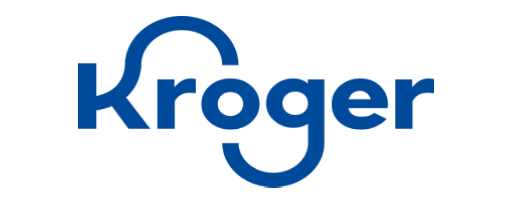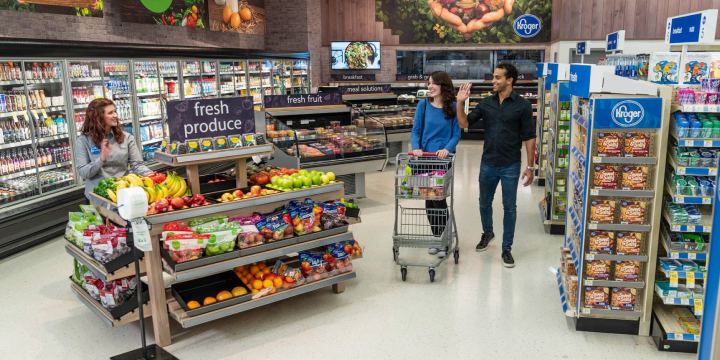Inside Kroger’s Innovation Machine:
AI, Automation, and the Quest for Grocery Dominance

Kroger, a century-old grocery giant, has consistently positioned itself at the forefront of the retail industry, leveraging a blend of tradition and cutting-edge technology to maintain its dominance. Headquartered in Cincinnati, Kroger operates over 2,800 stores under a variety of banners across the U.S., including well-known names such as Fred Meyer, Ralphs, Dillons, and Harris Teeter. In 2024, the company’s robust strategy continues to be a benchmark for grocery retailers, driven by a commitment to customer satisfaction, innovation, and operational efficiency.
One of the biggest developments in Kroger’s history is its proposed merger with Albertsons. Announced in 2022 for $24.6 billion, this merger would create the largest grocery network in the U.S., with nearly 5,000 stores under various banners. This historic deal, currently under federal investigation, has sparked significant industry buzz, with proponents arguing that it will enhance competition with other retail behemoths like Walmart, Amazon, and Costco.
Kroger CEO Rodney McMullen addressed concerns head-on, stating, “The day that we merge is the day that we will begin lowering prices.” The merger, according to McMullen, will help the combined entity leverage scale to bring down grocery prices while improving operational efficiency. To appease regulators, Kroger has proposed divesting over 579 stores, ensuring competition remains healthy.
This merger represents not just the union of two major grocery brands but also the beginning of a new era in retail, one where large-scale operations fuel cost savings, improved customer experiences, and greater competition with industry titans.
At the heart of Kroger's ongoing success is its unwavering commitment to technological innovation. Over the past few years, the company has increasingly embraced artificial intelligence (AI) and automation to refine its operations, particularly in e-commerce and fulfillment.
Kroger’s partnership with Ocado, a retail technology firm, has played a pivotal role in its fulfillment strategy. The grocer recently implemented Ocado’s advanced automation technologies in several of its Customer Fulfillment Centers (CFCs), which are responsible for a significant portion of its online delivery services. Two key innovations stand out: the On-Grid Robotic Pick and Automated Frameload.
The On-Grid Robotic Pick employs robotic arms with machine vision and reinforcement learning capabilities to pick and pack items with high precision. The Automated Frameload system, meanwhile, automates the labor-intensive task of loading customer orders onto delivery frames, reducing the need for manual intervention. By deploying these technologies, Kroger aims to cut down costs and increase efficiency in its rapidly expanding online grocery business.
In addition, the company has been optimizing its in-store pickup services using AI-driven solutions. "Through the power of machine learning and AI, we are developing new ways to elevate the Pickup experience for customers and at the same time reduce costs," McMullen said. This approach enables store associates to pick orders more efficiently, shortening pick lead times and improving customer satisfaction.
The day that we merge is the day that we will begin lowering prices.

Embracing AI and Automation to Drive Efficiency
The Kroger-Albertsons Merger: Shaping the Future of U.S. Grocery
Kroger's digital transformation efforts extend beyond just operational efficiency. The company has focused on enhancing both the customer and employee experiences through the strategic use of AI and machine learning.
The grocer has invested in generative AI technologies to improve personalization across its digital platforms, which has transformed how customers interact with its online marketplace. From creating more relevant marketing content to improving search results, AI is enabling Kroger to better meet customer expectations. As CIO Yael Cosset noted, “We view AI as a resource for our customers and associates to improve our human connections, not replace them.”
Another area of focus is digital circulars—weekly advertisements that are now fully integrated into Kroger’s online ecosystem. This move allows customers to engage with promotions and savings offers digitally, making it easier for them to shop while boosting Kroger's e-commerce sales.
For employees, Kroger has developed digital-first HR solutions, such as the "Fresh Start" employee app, which accelerates the hiring process and provides new employees with customized learning and training modules. This not only reduces the time to hire but also ensures that new hires can quickly master their job responsibilities. “We are measuring if the technology we are deploying improves the associate experience by monitoring Net Promoter Score for our associates' solutions,” Cosset added, signaling the company’s focus on using technology to enhance workplace satisfaction.
Kroger’s foray into retail media has been another key factor in its digital strategy. By tapping into the growing importance of first-party data, Kroger launched its Kroger Precision Marketing (KPM) platform, which allows brands to reach customers more effectively through targeted advertisements. KPM uses data-driven insights from Kroger’s loyalty programs to help advertisers tailor their messages to specific customer preferences, enhancing the impact of campaigns.
Retail media offers Kroger another avenue to drive revenue while leveraging its massive customer base and vast data pool. The company’s commitment to privacy, data security, and customer experience positions it as a leader in this emerging space, further distinguishing it from competitors.
Digital Transformation: Enhancing the Customer and Employee Experience
Expanding Retail Media: The Power of Data

Kroger's success can be attributed to its steadfast focus on understanding and meeting customer needs. Whether through personalized digital experiences, more efficient fulfillment options, or its expansive loyalty programs, Kroger continues to enhance the shopping experience for millions of customers.
The grocer’s extensive network of 2,800 stores, coupled with its growing e-commerce platform, ensures that it can meet the needs of a diverse customer base. From budget-conscious families to health-conscious shoppers looking for organic options, Kroger’s wide range of offerings makes it a preferred choice for millions of Americans.
In a rapidly evolving grocery landscape, Kroger’s leadership in omnichannel retail sets it apart. The grocer’s ability to seamlessly blend in-store and online experiences is evident in its continued investment in automated fulfillment, personalized shopping experiences, and convenient digital tools for customers and employees alike.
As Kroger continues its journey of digital transformation, it is clear that technology will play a central role in shaping its future. The company’s investments in AI, machine learning, and automation are not just about improving efficiency—they are about creating a more engaging, personalized, and convenient shopping experience for customers.
Kroger’s commitment to innovation, combined with its ability to adapt to changing consumer demands, positions it as a leader in the grocery industry. With the potential merger with Albertsons on the horizon, Kroger is poised to become an even bigger force in the U.S. grocery market, continuing to set new standards for how grocery retailers operate.
Kroger’s enduring success stems from its relentless pursuit of innovation and its commitment to delivering value for customers. By leveraging advanced technologies, streamlining operations, and enhancing both the customer and employee experiences, Kroger is shaping the future of grocery retail. As the company embarks on its next chapter, with a potential merger and a fully integrated digital ecosystem, it is clear that Kroger will continue to lead the way in the grocery industry for years to come.



